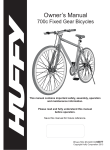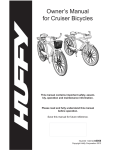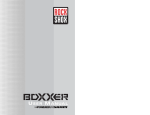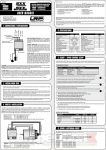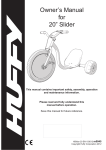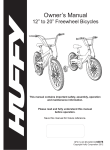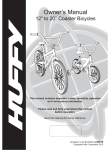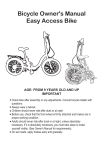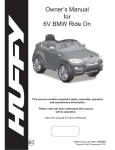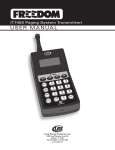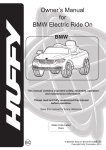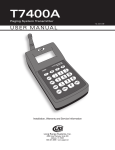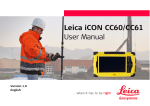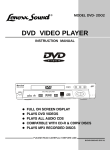Download Owner`s Manual `BMX` Bicycles
Transcript
Owner’s Manual ‘BMX’ Bicycles This manual contains important safety, assembly, operation and maintenance information. Please read and fully understand this manual before operation. Save this manual for future reference. Date Code Label Here H-DK BMX EN 072314 m0104 Copyright DK Bicycles 2014 Owner’s Manual Index Introduction • Owner’s Bicycle Identification Record.................................................... 3 • Fitting the Rider to the Bicycle................................................................ 3 • Warning and Safety Information............................................................. 4 • Freewheel Brakes................................................................................... 4 • Reflectors............................................................................................... 4 • Rules of the Road................................................................................... 4 • The Owner’s Responsibility.................................................................... 5 Components • Part Assembly View................................................................................ 6 • Parts Assembly List................................................................................ 7 Assembly • Introduction............................................................................................. 8 • Tools Needed.......................................................................................... 8 • Assemble the Front Wheel to the Fork................................................... 9 • Handlebar and Stem Installation - No Gyro Brakes............................... 10 • Gyro Brake and Stem Setup - Rear Brake............................................ 12 • Gyro Brake Setup - Front Brake Cable Install....................................... 14 • Seat Installation (various models).......................................................15/16 • Front and Rear Reflector Installation..................................................... 18 • Pedal Installation................................................................................... 19 • Testing Seat Clamp and Post Clamp Tightness.................................... 20 • Testing Stem and Handlebar Tightness................................................. 21 • Brake System Setup and Adjustment.................................................... 22 • Coaster Brakes (various models).......................................................... 26 • Pegs Installation.................................................................................... 27 Maintenance and Service • Repair and Service................................................................................ 28 • Chain Adjustment.................................................................................. 29 • Lubrication............................................................................................. 30 • Lubrication Table................................................................................... 31 • Inspection of the Bearings..................................................................... 32 • Tires ...................................................................................................... 33 Warranty • Limited Warranty..................................................................................34/35 Owner’s Bicycle Identification Record Introduction NOTE: This information is only available on the bicycle itself. It is not available from the manufacturer. Each bicycle has a Serial Number stamped into the frame. The Serial Number can be found on the bottom of the crank housing as shown (1). xxx 1 xx xx xxx Write this number below to keep it for future reference. If the bicycle is stolen, give this number and a description of the bicycle to the police. This will help them find the bicycle. Model / Serial Number: Purchase Date: Model Name: Fitting the Rider to the Bicycle To determine the correct size of bicycle for the rider: • Straddle the assembled bicycle with feet shoulder width apart and flat on the ground. • There must be at least 1 inch (2.5 cm) of clearance (1) between the highest part of the top tube (2) and the crotch of the rider with tires properly inflated. • The minimum leg-length for the rider is the highest part of the top tube plus one inch (3). 1 3 2 3 Warning and Safety Information Introduction Meanings of Warnings: a This symbol is important. See the word “CAUTION” or “WARNING” which follows it. The word “CAUTION” is before mechanical instructions. If you do not obey these instructions, mechanical damage or failure of a part of the bicycle can occur. The word “WARNING” is before personal safety instructions. If you do not obey these instructions, injury to the rider or to others can occur. • • • • • • • Adult assembly is required. Continuous adult supervision is required. Do not add a motor to the product. Do not tow or push the product. Do not modify the product. Replace worn or broken parts immediately. If anything does not operate properly, discontinue use. Freewheel Brakes • • • • • WARNING: Some models do NOT have a foot (pedal) brake. Ensure your child understands and can operate the hand brakes. Always use both hand brakes when stopping the bike. When stopping, apply front and rear brakes evenly. An unstable condition can occur if the front brake is used too hard resulting in injury to the rider or others. Reflectors WARNING: For your own safety, do not ride the bicycle if the reflectors are incorrectly installed, damaged, or missing. Make sure the front and rear reflectors are vertical. Do not allow the visibility of the reflectors to be blocked by clothing or other articles. Dirty reflectors do not work well. Clean the reflectors, as necessary, with soap and a damp cloth. Rules of the Road WARNING: Failure of the rider to obey the following “Rules of the Road” can result in injury to the rider or to others. 4 • Obey all traffic regulations, signs, and signals. • Always wear a bicycle helmet that meets CPSC safety standards, as well as local safety standards. • • • • • Always wear shoes. Ride on the correct side of the road, in a single file, and in a straight line. Bikes under 20” not intended for use on roads. Avoid riding at night, dusk, dawn and any other time of poor visibility. Make sure the reflectors of your bicycle are correctly positioned. Do not remove the reflector or replace the reflectors with lighted devices that look similar to reflectors. • Do not let anything cover the reflectors. • Use extra caution in wet weather: Introduction Rules of the Road - continued • Ride slowly on damp surfaces because the tires will slide more easily. • Avoid these hazards to prevent loss of control or damage to your wheels: • Be aware of drain grates, soft road edges, gravel or sand, pot holes or ruts, wet leaves, or uneven paving. • Cross railroad tracks at a right angle to prevent the loss of control. • Avoid unsafe actions while riding. • Do not carry any passengers. • Do not carry any items or attach anything to your bicycle that could hinder your vision, hearing, or control. • Do not ride with both hands off the handlebar. The Owner’s Responsibility WARNING: This bicycle is made to be ridden by one rider at a time for general transportation and recreational use. It is not made to withstand the abuse of stunting and jumping. If the bicycle was purchased unassembled, it is the owner’s responsibility to follow all assembly and adjustment instructions exactly as written in this manual, and any “Special Instructions” supplied and to make sure all fasteners and components are securely tightened. NOTE: Periodically check that all fasteners and components are securely tightened. If the bicycle was purchased assembled, it is the owner’s responsibility, before riding the bicycle for the first time, to make sure the bicycle has been assembled and adjusted exactly as written in this manual, and any “Special Instructions” supplied and to make sure all fasteners and components are securely tightened. NOTE: If product is assembled, please proceed to the following sections: • Testing Seat Clamp and Post Clamp Tightness • Testing Stem and Handlebar Tightness 5 6 2 3 4 24 25 26 27 28 29 30 Components 17 6 8 11 31 15 16 32 1 13 12 14 18 19 20 21 23 22 33 5 3 4 34 9 10 7 22 21 Part Assembly View Chain Guard Handlebar Stem Right Pedal Left Pedal 10 11 12 13 Seat Post Clamp Chain 9 18 Lower Brake Cable Coupler (various models) 8 Front Pegs Crank and Spindle Set 7 17 Fork 6 Front Axle Nut (x2) Rear Wheel Assembly 5 16 Tube (x2) 4 Kick Stand Tire (x2) 3 Wheel Retainer (x2) Front Wheel Assembly 2 15 Frame 1 14 Description No. Components 34 33 32 31 30 29 28 27 26 25 24 23 22 21 20 19 No. Rear Pegs Rear Axle Nut (x2) Grips (x2) Left Brake Lever Right Brake Lever Upper Brake Cable Coupler (various models) Handlebars Front Reflector Gyro Head Set Head Set Bearings Front Brake Rear Brake Seat Seat Post Hardware Rear Reflector Seat Post Description Parts Assembly List 7 Introduction Assembly This Owner’s Manual is made for several different bicycles: • Some illustrations may vary slightly from the actual product. • Follow instructions completely. • If the bicycle has any parts that are not described in this manual, look for separate “Special Instructions” that are supplied with the bicycle. • Models may have different accessory items such as bags, baskets, reflectors, cup holders, racks, etc. • All features, components and accessories are not included on all models. • Use the Index page to locate specific sections of this manual. • Please read through this entire manual before beginning assembly or maintenance. • If you are not confident with assembling this unit, refer to a local bike shop. WARNING: Keep small parts away from children during assembly. NOTE: All of the directions (right, left, front, rear, etc.) in this manual are as seen by the rider while seated on the bicycle. Do not dispose of the carton and packaging until you complete the assembly of the bicycle. This can prevent accidentally discarding parts of the bicycle. Tools Needed 8 Small Adjustable Wrench (Jaws must open at least 9/16 inch.) Open-end Wrenches Flat-blade Screwdriver Phillips Screwdriver Slip-Joint Pliers Metric Allen Wrenches 1. If the Axle Nuts (A) are already attached to the front wheel axle, begin by removing them with an open end wrench or adjustable wrench. 2. Set the wheel into the front fork (B). 3. Install Step Washers (C) making sure the small end goes towards the fork Indent (D). 4. If installing Axle Pegs (E), follow instructions on pages 27 and 28. 5. Attach the front wheel with the Axle Nuts. 6. Tighten Axle Nuts to 21 ft-lbs (28.4 N•m). Assembly Assemble the Front Wheel to the Fork B D C A C A E NOTE: Some models may have Wheel Retainers (F) instead of Step Washers (C). Install Wheel Retainers (F) making sure the Tabs are in the Fork (G) Tab Holes. G NOTE: Ensure wheel spins freely without contacting fork or fender. WARNING: Do not use Nuts (A) without serrations to attach the front wheel. WARNING: Put the wheel in the center of the fork and tighten both nuts to the recommended torque of 21 ft-lbs (28.4 N•m) F WARNING: Failure to obey these steps can allow the front wheel to loosen while riding. This can cause injury to the rider or to others. 9 Assembly Handlebar and Stem Installation - No Gyro Brake WARNING: To prevent steering system damage and possible loss of control, the “MIN-IN” (minimum insertion) mark (A) on the stem must be below the top of the Locknut (B). NOTE: Remove plastic Cap (E) from the end of the Stem (11). D 1. Insert the Stem (11) into the fork (fig 07). 2. Point the Stem towards the front of the bike. 3. Tighten the Stem Bolt (C) just enough to hold it in position. 4. If necessary, loosen the Handlebar Screws (D) and rotate Handlebar (28) into a comfortable riding position. 5. Tighten Handlebar Screws (D) just enough to hold it in position (fig 08). 6. Align the stem with the front tire and tighten the Stem Bolt (C) securely (fig 07). C 11 A E B fig 07 B A WARNINGS: • Do not over tighten the stem bolt. Over tightening the stem bolt can damage the steering system and cause loss of control. • If the handlebar clamp in not tight enough, the handlebar can slip in the stem. This can cause damage to the handlebar or stem, and can cause loss of control. 10 Handlebar and Stem Installation - continued Assembly Four Bolt Clamp Top Mount: • If necessary, re-adjust Handlebar. • Tighten Clamp Screws (D) evenly according to pattern. D NOTE: Do not over tighten. Torque to 17 ft-lbs. 3 1 2 4 28 Four Bolt Clamp, Front Mount: • If necessary, re-adjust Handlebar. • Tighten Clamp Screws (D). fig 08 28 NOTE: Do not over tighten. Torque to 17 ft-lbs. D 3 1 2 4 fig 08b Two Bolt Stem: • • • Loosen Clamp Screws (A). Re-adjust Handlebar (B) to a comfortable riding position. Tighten Clamp Screws (A). B A NOTE: Do not over tighten. Torque to 17 ft-lbs. WARNINGS: • Do not over tighten the stem bolt. Over tightening the stem bolt can damage the steering system and cause loss of control. • If the handlebar clamp in not tight enough, the handlebar can slip in the stem. This can cause damage to the handlebar or stem, and can cause loss of control. 11 Stem and Handlebar Setup - Gyro Brake Assembly Note: The Handlebar Stem Clamp may be pre-installed from the factory. • Carefully unpack Handlebar and Brake Cables. • If needed, loosen the Stem Bolt (A) and point the Stem (B) towards the front of the bike as shown. • Tighten the Stem Bolt securely. • Install the Handlebar (C) and rotate to a comfortable riding position. • Tighten Clamp Screws (D) securely. C D A 3 1 2 4 B Gyro Stem and Brake Setup • Make sure Rear Brake Cable Sheath (A) is fully inserted into the adjustment Housing at the Caliper and Hand Lever (B). • Ensure Housing Nut and Housing (B, C) are adjusted all the way in towards the Hand Lever. • Rotate Housing (B) Groove away from Cable Groove (D) and tighten Housing Nut (C). 12 A B D C continued >> Gyro Stem and Brake Setup - continued • Install the two Cable Adjusters (A) into the Gyro Plate (B) making sure the Shorter Cable (C) is on the same side as the Brake Lever (D). • Turn the Cable Adjusters and Nuts (E) all the way into the Gyro Plate - hand tight. C A E Assembly D A B • Squeeze the two sides of the Gyro Plates (A) together and insert the Cable End (B) into the Gyro Plate Slot (C). • Repeat for other side. A B C WARNING: Ensure Gyro Handlebar/Stem/Wheel system can rotate 360 degrees without binding any Cables and that the Gyro mechanism works smoothly. continued >> 13 Assembly Gyro Brake Setup - Front Brake Cable Install • Pull the Front Brake Cable (A) up through the Stem Nut (B) so that it is routed as shown. • Ensure the Brake Cable does not touch the Tire (C). 1 A • Insert Cable Barrel (2-1) into Brake Lever. 2 B 2-1 2-1 • Insert Brake Cable (3-1) into Groove as shown. C 3 A 3-1 • Ensure Housing Nut and Housing (4-3, 4-1) are adjusted all the way in towards the Hand Lever. • Rotate Housing (4-1) Groove away from Cable Groove (4-2) and tighten Housing Nut (4-3). 14 4 4-2 4-1 4-3 continued >> Gyro Brake Setup - Front Brake Cable Install - continued Assembly • Rotate Brake Levers (A) into a comfortable riding position and tighten securely. A WARNING: Ensure Gyro Handlebar/Stem/Wheel system can rotate 360 degrees without binding any Cables and that the Gyro mechanism works smoothly. Seat Installation (various models) Attach Seat to Seat Post: (pre-assembled on some models) • If needed, loosen nuts on seat clamp (A) and rotate Seat (22) into riding position. • Put the Seat Post (19) fully through the seat clamp. • Tighten the Seat Clamp so the seat stays on the seat post. • If the Seat Clamp has a nut on each side, tighten both nuts equally. 22 A 19 fig 09 CAUTION: If you accidentally drop the seat post into the seat tube, it may be difficult to remove it. continued >> 15 Assembly Seat Installation (various models) - continued • Point the Seat (22) forward and put the Seat Post (19) into the Seat Tube (B) (figs 10, 11). WARNING: To prevent the seat coming loose and possible loss of control, the “MIN-IN” (minimum insertion) mark (C) on the seat post must be below the top of the Seat Tube (B). Tighten the quick release lever: • Move the Quick Release Lever (D) to the “open” position so the word “open” is pointing away from the Seat Post Clamp (E). C 22 B B 19 C fig 10 19 B F E NOTE: The words “open” and “close” are on opposite sides of the quick release lever. D fig 11 Seat to Seat Post (Single Bolt Style): Some models are equipped with a seat and seat post assembly that uses a single bolt and nut to secure the seat to the seat post. The seat is assembled to the seat post at the factory. Ensure the seat is secure to the seat post and the seat bolt is tightened. Recommended torque = 7.3 ft-lbs (10 N•m). 16 22 21 Seat Installation - continued You must use strong force to move the quick release lever to the “close” position. If you can easily move the lever to the “close” position, the clamping force is too light. WARNING: If the clamping force of the Quick Release Lever is too light, the seat post can loosen while riding. This can cause injury to the rider or to others. Assembly CAUTION: Operate the Quick Release Lever (D) by hand only. Do not use a hammer or any other tool to tighten the quick release lever. Tighten the quick release lever (continued): • Open and close the Quick Release Lever with one hand while you turn the Adjusting Nut (F) with the other hand (fig 11). • Tighten or loosen the adjusting nut by hand, so that you first feel resistance to the quick release lever when it perpendicular to the bicycle frame. • Push the Quick Release Lever to the “close” position (fig 11). • When in the “close” position, make sure the Quick Release Lever lays against the Seat Post Clamp (E). • The tightening torque of the Quick Release Lever should be tight enough so that the seat does not move during normal operation. Seat Bolt Mount (various models) Some models have a Bolt (A), Washer (B) and Nut (C) instead of a Quick Release Lever. • If needed, loosen the nut enough to insert the Seat Post. • Point the seat forward and insert Seat Post to the Minimum Insertion marks (D). • Tighten Nut securely so it supports the rider without moving. C D B A fig 24 17 Front and Rear Reflector Installation Assembly 1. Position FRONT Reflector (27) so it points straight forward. 2. Tighten Clamp Screw. NOTE: Do not over-tighten. This will damage the Clamp. 27 fig 12 20 1. Position REAR Reflector (20) so it points straight backwards. 2. Tighten Clamp Screw. NOTE: Do not over-tighten. This will damage the Clamp. Red. 18 WARNING: Ensure the Front Reflector is White and the Rear Reflector is Pedal Installation • The pedal marked “R” has right-hand threads. Tighten it in a clockwise direction. • The pedal marked “L” has left-hand threads. Tighten it in a counterclockwise direction (anti-clockwise). • Turn the right pedal marked “R” into the right side of the crank arm, and the left pedal marked “L” into the left side of the crank arm. Assembly CAUTION: There is a right pedal marked “R” and a left pedal marked “L”. Tighten the pedals (fig 14): • Make sure the threads of each pedal are fully into the crank arm. NOTE: The recommended torque (tightness) for each pedal is 30 ft-lbs. WARNING: Ensure pedals are secure in crank arms so they will not loosen. Periodically check tightness. L R fig 14 Note: A Pedal Wrench is preferred for attaching Pedals. An open-end wrench can also be used as shown. 19 Testing Seat Clamp and Post Clamp Tightness Assembly To test the tightness of the seat clamp and the post clamp: WARNING: Every time the quick release mechanism is loosened, make sure the red reflector is correctly positioned. • • Try to turn the seat side-to-side and to move the front of the seat up and down. If the seat moves in the Seat Clamp (A): • Loosen the Seat Clamp (A). • Put the seat in the correct position and tighten the Seat Clamp tighter than before. • Do this test again, until the seat does not move in the Seat Clamp. 22 A 19 fig 09 • If the Seat Post (A) moves in the Seat Tube (B): • Move the Quick Release Lever to the “open” position OR loosen the Clamp Bolt and Nut (C). • Put the seat in the correct position and tighten the Quick Release Lever tighter than before OR tighten the Clamp Bolt and Nut tighter than before. • If necessary, loosen Quick Release Lever, tighten Adjusting Nut (D) and re-tighten Quick Release Lever. • Do this test again, until the seat post does not move in the seat tube. A A B B D C 20 C Testing Stem and Handlebar Tightness • Straddle the front wheel between your legs. • Try to turn the front wheel by turning the handlebar. • If the handlebar and stem turn without turning the front wheel, realign the stem with the wheel and tighten the stem bolt(s) tighter than before (about 1/2 revolution only at a time). • Do this test again, until the handlebar and stem do not turn without turning the front wheel. Assembly To test the tightness of the stem: To test the tightness of the handlebar clamp: • Hold the bicycle stationary and try to move the ends of the handlebar up and down or forward and back. WARNING: Do not exceed 100 lbs force. • If the handlebar moves, loosen the bolt(s) of the handlebar clamp. • Put the handlebar in the correct position and tighten the bolt(s) of the handlebar clamp tighter than before. • If the handlebar clamp has more than one bolt, tighten the bolts equally. • Do this test again, until the handlebar does not move in the handlebar clamp. 21 Brake System Setup and Adjustment Assembly WARNING: You must adjust the front brakes before you ride the bicycle. NOTE: FRONT AND REAR BRAKE SETUP IS THE SAME. Brake Shoe Adjustment: B A Step One: Put the brake shoes (B) in the correct position: • Loosen the Screw (A) of each Brake Shoe (B). • Adjust each Brake Shoe so it is flat against the rim and aligned with the curve of the rim. • Make sure each Brake Shoe does not rub the tire. • If the surface of the Brake Shoe has arrows, make sure the arrows point toward the rear of the bicycle. • Hold each Brake Shoe in position and tighten the Screw. Step Two: Test the tightness of each Brake Shoe: • Try to move each Brake Shoe out of position. • If a Brake Shoe moves, do Step 1 again, but tighten the nut tighter than before. • Do this test again, until each Brake Shoe does not move. 22 Brake System Setup and Adjustment - continued Brake System Adjustment: 1 Assembly 1. Loosen Cable Nut (1-1) so that the cable is loose. 1-1 2. Insert Cable Barrel (2-1) into Brake Lever. 2 2-1 2-1 3. Insert Brake Cable (3-1) into Groove as shown. 3 3-1 continued >> 23 Brake System Setup and Adjustment - continued 4. Rotate Housing (4-1) Groove away from Cable Groove (4-2) and tighten Housing Nut (4-3). 4-2 Assembly 4 4-1 4-3 5. Squeeze Brake Arms (5-1) so that Brake Pads (5-2) are against the Rim. 5 5-1 5-2 6. Pull Brake Cable (6-1) tight. • Tighten Cable Nut (6-2). • Adjust Cable Nut (6-3) for 1/16” (1.58 mm) Brake Pad clearance. 5-2 6 6-3 6-2 6-1 1/16” 1/16” (1.58mm) 24 Brake System Setup and Adjustment - continued 7. Make sure the Brake Lever is not loose (7-1). 0 7 Assembly 7-1 8. Make sure the cable sheaths are fully inserted into the adjustment housing at the Caliper (8-1) and Hand Lever (8-2). 8 8-1 8-2 • Rotate Brake Levers (A) into a comfortable riding position and tighten securely. A 25 Coaster Brakes (various models) Assembly These models are equipped with a rear ‘coaster’ brake that is operated by rotating the crank backwards. Operation: Operate the coaster brake as follows: • Push the pedals backward to move the chain backward • The chain activates the coaster brake mechanism that is inside the rear wheel hub • As you push the pedals backward with increasing force, the braking action of the coaster brake increases. If your bicycle has a caliper brake(s) in addition to the coaster brake, always use the coaster brake as the main brake to stop the bicycle. WARNING: If you do not obey the following instructions, injury to the rider or to others can occur : • When you ride the bicycle the first time, test the coaster brake and practice using it at a low speed in a large level area that is free of obstructions. • Every time the bicycle is ridden, make sure the clamp (A) on the brake arm (B) is securely attached to the chain stay (C) of the bicycle frame. The coaster brake will not work correctly if the brake arm is not attached to the chain stay. (fig 15a) C A B 26 NOTES • Front and rear pegs may be different sizes. • The pegs are optional. You may choose not to install them on the axles. Pegs can be installed on the front, rear or on one side. • The same procedure is used to install pegs on both the front and rear axles. Front wheel axle is shown. Threaded pegs: • No additional tools are necessary to install the pegs. • Put a peg (A) on each end of the axle. • Make sure the peg is fully seated against the frame or fork. Tighten the peg securely. • Pegs will go over the axle nuts (B). Accessories Pegs Installation - Threaded B A • • • • • • • • WARNINGS: Do not ride beyond your capabilities. Pegs should be installed by an adult. Check before each ride. Ensure there is no damage to frame, fork or wheels during install and use. Ensure chain is properly adjusted after install. Ensure wheels are properly aligned after install. If damaged, stop use and replace. Failure to obey these steps can allow the front wheel to loosen while riding. This can cause injury to the rider or others. 27 Accessories Pegs Installation - Bolt on NOTES • Front and rear pegs may be different sizes. • The pegs are optional. You may choose not to install them on the axles. Pegs can be installed on the front, rear or on one side. • The same procedure is used to install pegs on both the front and rear axles. Front wheel axle is shown. Pegs that are not threaded: • A socket wrench, a metric socket which fits the axle nuts, and a three-inch socket extension are necessary to install the pegs. • Remove the Axle Nuts (A) if previously installed when attaching wheel to Fork (B) • Install Step Washers (C) making sure the small end goes towards the fork Indent (D). • Put a Peg (E) on each end of the axle. • Put an Axle Nut (A) down inside each peg, and onto the end of the axle. Ensure the serrated side (F) of the Axle Nut is toward the wheel. • Put the wheel in the center of the fork or frame and tighten both nuts to the recommended torque of 21 ft-lbs (28.4 N•m). NOTE: Some models may have Wheel Retainers instead of Step Washers. Install Wheel Retainers making sure the Tabs are in the Fork Tab Holes (view D). • • • • • • • • • 28 D B C F E A WARNINGS: Do not use Axle Nuts (A) without serrations (F) to attach the wheels. Do not ride beyond your capabilities. Pegs should be installed by an adult. Check before each ride. Ensure there is no damage to frame, fork or wheels during install and use. Ensure chain is properly adjusted after install. Ensure wheels are properly aligned after install. If damaged, stop use and replace. Failure to obey these steps can allow the front wheel to loosen while riding. This can cause injury to the rider or others. WARNING: • Inspect the bicycle frequently. Failure to inspect the bicycle and to make repairs or adjustments, as necessary, can result in injury to the rider or to others. Make sure all parts are correctly assembled and adjusted as written in this manual and any “Special Instructions”. • Immediately replace any damaged, missing, or badly worn parts. • Make sure all fasteners are correctly tightened as written in this manual and any “Special Instructions”. Parts that are not tight enough can be lost or operate poorly. Over tightened parts can be damaged. Make sure any replacement fasteners are the correct size and type. Maintenance and Service Repair and Service NOTE: Have a bicycle service shop make any repairs or adjustments for which you do not have the correct tools or if the instructions in this manual or any “Special Instructions” are not sufficient for you. Chain Adjustment WARNING: The chain must remain on the sprockets. If the chain comes off the sprockets, the coaster brake will not operate. WARNING: Do not attempt chain repairs. If there is a problem with the chain, have a bicycle service shop make any repairs. C B A fig 16 Adjustment (fig 16): The chain must be at the correct tightness. If too tight, the bicycle will be difficult to pedal. If too loose, the chain can come off the sprockets. When the chain (C) is at the correct tightness, you can rotate the crank freely and you can pull it no more than one-half inch (A) away from a straightedge (B) as shown. Adjust the tightness of the chain as follows: • Loosen the axle nuts of the rear wheel. • Move the rear wheel forward or backward as necessary. NOTE: Make sure the rear wheel is in the center of the bicycle frame. • Hold the wheel in this position and tighten the axle nuts to 21 ft-lbs (28.4 N•m). 29 Maintenance and Service Lubrication 30 WARNING: • Do not over lubricate. If oil gets on the wheel rims or the brake shoes, it will reduce brake performance and a longer distance to stop the bicycle will be necessary. Injury to the rider or to others can occur. • The chain can throw excess oil onto the wheel rim. Wipe excess oil off the chain. • Keep all oil off the surfaces of the pedals where your feet rest. • Using soap and hot water, wash all oil off the wheel rims, the brake shoes, the pedals, and the tires. • Rinse with clean water and dry completely before you ride the bicycle. • Using a light machine oil (20W), lubricate the bicycle according to the following table: What When How Brake Levers every six months Put one drop of oil on the pivot point of each brake lever. Caliper Brakes every six months Put one drop of oil on the pivot point of each caliper brake. Brake Cables every six months Put four drops of oil into both ends of each cable. Allow the oil to soak back along the cable wire. Pedals every six months Put four drops of oil where the axles go into the pedals. Chain every six months Put one drop of oil on each roller of the chain. Wipe all excess oil off the chain. Gyro Head every six months Put 4 drops of oil around the Gyro Head Bearings. Maintenance and Service Lubrication Table 31 Maintenance and Service Inspection of the Bearings Maintenance Frequently check the bearings of the bicycle. Lubricate the bearings according to the lubrication chart or any time they do not pass the following tests: Head Tube Bearings The fork should turn freely and smoothly at all times. With the front wheel off the ground, you should not be able to move the fork up, down, or side-to-side in the head tube. Crank Bearings The crank should turn freely and smoothly at all times and the front sprockets should not be loose on the crank. You should not be able to move the pedal end of the crank from side-to-side. Wheel Bearings Lift each end of the bicycle off the ground and slowly spin the raised wheel by hand. The bearings are correctly adjusted if: • The wheel spins freely and easily. • The weight of the spoke reflector, when you put it toward the front or rear of the bicycle, causes the wheel to spin back and forth several times. • There is no side-to-side movement at the wheel rim when you push it to the side with light force. Gyro Bearings With the front wheel off the ground the Gyro Handlebar/Stem/Wheel system should rotate freely and smoothly 360 degrees without binding or hitting any cables. 32 Maintenance: • Frequently check the tire inflation pressure because all tires lose air slowly over time. For extended storage, keep the weight of the bicycle off the tires. • Do not use unregulated air hoses to inflate the inner tubes. An unregulated hose can suddenly over inflate bicycle tires and cause them to burst. • Replace worn tires. WARNING: Do not ride or sit on the bicycle if a tire is under inflated. This can damage the tire and inner tube. Inflating the Tires: • • • • Use a hand or a foot pump to inflate the tires. Service station meter-regulated air hoses are also acceptable. The maximum inflation pressure is shown on the tire sidewall. If two inflation pressures are on the tire sidewall, use the higher pressure for onroad riding and the lower pressure for off-road riding. • The lower pressure will provide better tire traction and a more comfortable ride. Maintenance and Service Tires Before adding air to any tire, make sure the edge of the tire (the bead) is the same distance from the rim, all around the rim, on both sides of the tire. If the tire does not appear to be seated correctly, release air from the inner tube until you can push the bead of the tire into the rim where necessary. Add air slowly and stop frequently to check the tire seating and the pressure, until you reach the correct inflation pressure. 33 Warranty Information Huffy Limited Warranty • Part or model specifications are subject to change without notice. • This Limited Warranty is the only warranty for this product. There are no other expressed or implied warranties. • This Limited Warranty extends only to the original consumer and is not transferable to anyone else. • Warranty registration is not required. • The only uses for this product are described in this manual. What does this Limited Warranty cover? This Limited Warranty covers all parts of the bicycle. What must you do to keep the Limited Warranty in effect? This Limited Warranty is effective only if: • Bicycle is completely and correctly assembled. • Bicycle is used under normal conditions for its intended purpose (see the following section for excluded activities). • Bicycle receives all necessary maintenance and adjustments. • Bicycle is used for general transportation and recreational use only. What is not covered by this Limited Warranty? • This Limited Warranty does not cover normal wear and tear, normal maintenance items, or any damage, failure, or loss that is caused by improper assembly, maintenance, adjustment, storage, or use of the bicycle. This Limited Warranty will be void if the bicycle is ever: • Used in any competitive sport • Used for stunt riding, jumping, aerobatics or similar activity • Installed with a motor or modified in any other way • Ridden by more than one person at a time • Rented • Used in a manner contrary to the instructions and warnings in this Owner’s Manual Huffy will not be liable for incidental or consequential loss or damage, due directly or indirectly from use of this product. Some states do not allow the exclusion or limitation of incidental or consequential damages, so the above limitation may not apply to you. 34 For how long does this Limited Warranty last? • The frame is warranted for life except aluminum frames which are warranted for ten (10) years, from the date of purchase. • The fork is warranted for life except for shock forks which are warranted one (1) year from date of purchase. • All other components are warranted for six (6) months from the date of purchase. What will Huffy do? Huffy will replace, without charge to you, the component found to be defective by Huffy. The original owner must pay all labor and transportation charges connected with the repair or warranty work. Maintenance and Service Huffy Limited Warranty - continued How do you get service? Contact Consumer Service. See included list for Customer Contact information. What rights do you have? This warranty gives you specific legal rights. You may also have other rights which vary from state to state. 35 WARNING: ALWAYS WEAR YOUR HELMET WHEN RIDING THIS PRODUCT! • • • • • Helmet should sit level on your head and low on your forehead Adjust the strap sliders below the ear on both sides. Buckle the chin strap. Adjust strap until it is snug. No more than two fingers should fit between the strap and your chin. A proper fitting helmet should be comfortable and not rock forward/backward or side to side. • Always read the user manual that comes with your helmet to make sure it is fitted and attached properly to the wearer’s head according to the fitting instructions described in the user manual.






































